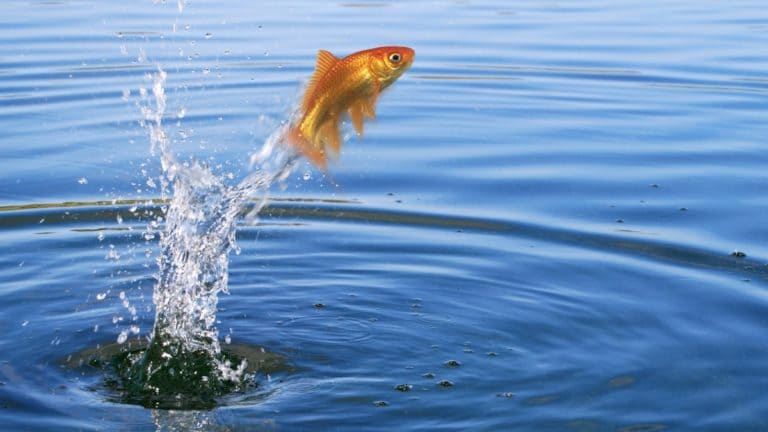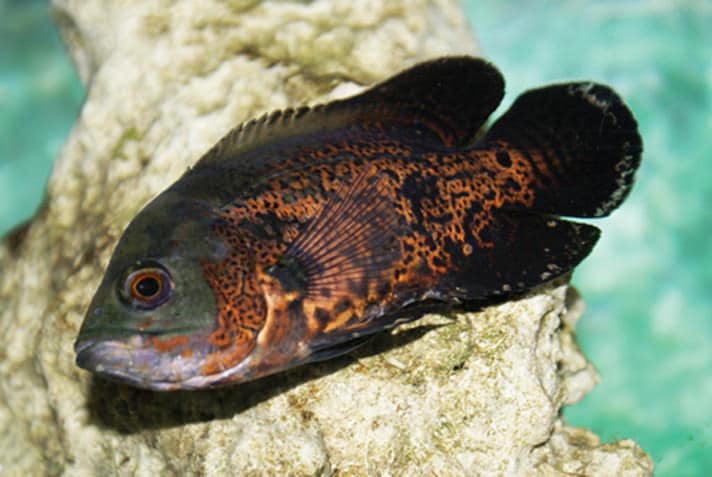Some hobbyists want their fish to be mean. They like it when their fish kick each other’s tail fins. When I was an aquarium retailer, such hobbyists would come into the store and ask what was the most aggressive fish. I dreaded that question because it was a hard one to answer — a judgment call at best.
And I dreaded it because no matter which species I pointed to as being the most psychotic, murderous fish in stock, the next question was always a harder one to answer: The hobbyist would want to know if the fish in question would get along with a list of other murderous, psychotic species they already owned. When you want to find a fish that will get along with your other fish, you probably shouldn’t start looking for the baddest fish in the store.
Most hobbyists want their fish to coexist peacefully. They enjoy the calming effect of watching a relaxing community of fish in a peaceful aquarium. When a specimen deviates from friendly behavior, there’s reason for concern. Unfortunately, things can go wrong even in a well-planned community. That’s just the way it is. In nature, the strong dominate the weak; bullies torment the gentle; and many species simply view others as fish food. Even a peaceful species can have the occasional “criminal” individual.
In this article, we’ll talk about aggression. We’ll start by discussing the things that make fish fight because the more you understand about fish behavior, the more you can anticipate and prevent aggression problems in your fish aquarium. And for those times when the best planning fails and things still go wrong, we’ll list steps you can take that might make all the difference.
Gills Gone Wild
So, what makes a fish fight? It shouldn’t surprise you that fish fight over the same things that people do: food, mates, territory and so forth. It’s a good thing fish aren’t religious or political.
Most aggression in the aquarium occurs over territory. Many species swim wherever they want and are fancy-free. They go where the current takes them; but others like to stake a claim to a certain area and call it home. Their territory provides a safe place to rest, hide or breed. The spot they claim may be the area surrounding a piece of driftwood or a corner of the aquarium. It might be a cave or large rock or an overhang of floating aquatic plants. Whatever spot they choose, the fish will allow some others to enter that area and punish others for coming too close.
How does the fish “decide”? There are several factors. The first is whether the other individual is of the same species. In general, territorial fish are usually most territorial toward fish of their own species. They are particularly likely to be aggressive toward others of their own species that are also the same sex. That’s because one of the primary reasons for holding territory is to prepare a safe site for breeding, then to guard eggs and fry.
So, if another fish looks to be of the same species, the same sex and a possible rival, it’s likely to be driven off. It depends on the reaction of the encroacher. If it is merely a neighbor wandering by, a gentle threat display or chase will drive it away. However, if the encroacher is a fish looking to take over the territory or steal a mate, a more fierce battle may ensue to determine if the current owner stays or goes. If the encroaching fish is of the opposite sex, a mating display may result.
Fish use many things to determine if other fish are enemies. Color, pattern and shape can come into play. The more a fish sees another fish as similar to itself, the more likely it will become a target. For example, the betta fish (Betta splendens) will occasionally bother nonbetta species that happen to be red. Although hobbyists have bred bettas into strains of various colors, the bettas still “know” deep down that wild bettas have red fins. So, the red color of a platy or serpae tetra can be enough to make some bettas aggressive toward fish shaped nothing like bettas and not competing for territory or mates.
Signs of Aggression
Some of the time, fights are obvious. You’ll see the bully beating on its victims. But not always. In fact, it’s more likely you’ll only later discover the damage done rather than see the fight itself. The fighting mostly occurs when there are no witnesses. It’s not that fish are smart enough to avoid the eyes of humans when they are misbehaving — it’s just that you can’t spend all your time looking at your aquarium, so you’re not there to see. Besides, when you are there, the fish are likely to be pressing their noses against the glass to beg for fish food. Their attention is going to be on feeding, not fighting.
Watch for symptoms of fighting. Do any fish have split fins? Tail rot causes ragged edges on fins, but split fins are a sign of damage from tussling. Are any fish suddenly hiding? It could be from fear of a bully. Have any fish changed territories? Watch for scratches and scrapes, torn lips and missing scales. Are there obvious wounds or sores? Is anyone missing an eye?
When Fish Attack!
In the barnyard, chickens peck at those they think have lesser status. In turn, they suffer pecks from more dominant chickens. A hierarchy results that is known as the pecking order. The most dominant chicken is at the top of the pecking order. It’s usually a fine specimen with perfect feathers. The most submissive, most harassed chicken is at the bottom of the pecking order. It’s often a scraggly bird with feathers missing from its neck. And fish set up a pecking order, too.
What can you do when the tropical fish in your aquarium start banging heads? If you witness a fight, your first reaction will probably be to grab a net and use the handle to separate the combatants. That will usually work temporarily but is not likely to solve the problem for long. The fish will just go at it again later. Letting the fish spar is actually a good first choice because it’s usually best to let the fish try to work it out among themselves.
Sometimes, fish just need to learn their place in the pecking order for things to settle down. The pecking order is likely to change over time as various individuals grow and mature. Even an aquarium that has been peaceful for a long time can go through a period of upheaval.
Later, if it’s clear that the situation isn’t self-correcting, you’ll need to take stronger action. Because it’s usually territorial fish that fight, the first thing you can try is to rearrange the decorations in the aquarium. Move the driftwood, rocks and aquatic plants. Add some; subtract some. Make the aquarium look different. This forces the fish to establish new territories and can take away the advantage of a bully that already has its spot picked.
Try to arrange the decorations in a way that provides plenty of hiding places for your fish and visual barriers. With aggressive fish, out of sight is usually out of mind. Merely moving a large decoration or group of aquatic plants may allow two previous sparring partners to set up territories where they don’t have to feel the threat of being watched all day. Redecorating is a good choice when adding new fish, as well. It doesn’t leave them as the only fish without territory.
Time for Separation
When the steps I’ve suggested fail, you may have no choice but to separate the opponents. The first decision you will have to make is which fish to move. It’s a judgment call. Most hobbyists move the fish receiving the most beatings to protect it. If the injuries are severe, you will have no other choice because the injured fish becomes a target. All the fish start to join in, taking nips at wounds and causing further damage. Infection can set in and kill the victim. However, if injuries are minor, removing the victim is usually the wrong choice; it rewards the bully’s behavior, and the intimidator is likely to focus on its next victim. The bully remains at the top of the pecking order.
So my first choice is to set up a “fishy jail.” For small to medium fish, buy a net breeder and hang it in a corner. You can isolate the bully inside for a week. It’ll be able to see and smell the other fish but won’t be able to attack them. It also lets the other fish establish stronger territories, so it may move the bully down the pecking order. I like the coarse mesh net breeders best because they let fish food and droppings fall through the bottom. You can also use the net breeder to isolate a slightly wounded fish so that it can heal without further injury. This has the advantage of letting the other fish see and smell the fish, so it won’t be viewed as a newcomer when reintroduced to the aquarium. You can also buy aquarium dividers to separate fish in your aquarium.
Of course, the solutions I’ve mentioned don’t always work. Sometimes the damage to the victim is so bad it will need to move to a separate aquarium for medical treatment. Other times, the bully just causes more problems when reintroduced to the main aquarium and must be permanently separated. Don’t forget that when territorial fish grow, so do their territories. If you didn’t plan for this when you stocked your aquarium, a time will come when you will have to move some fish to other aquariums.
It’s easy to set up a quarantine aquarium to medicate a beaten fish or to temporarily isolate a bully. Usually, a bare 5- or 10-gallon aquarium will work. Add a rock, piece of driftwood or plastic plants to provide a bit of cover for the fish, and a glass canopy to keep it from jumping out. A light isn’t necessary. You may need a heater, depending on where you live and the time of year; any small filter will work. I like to use sponge filters because they also work well if you want to use the aquarium to breed fish later. Sponge filters won’t capture eggs or fry.
For injured fish, medication may not be necessary. Fish can heal themselves if provided clean water, good fish food and isolation from further damage. You may choose to gently net the fish and dab some iodine or mercurochrome on the wounds. Because a fish’s slime coat is its first defense against infection, adding a product containing colloids that temporarily bond to the fish until it regenerates its own slime, such as a conditioner made to deal with stress or fish slime, will help the fish regenerate a slime coat. A teaspoon of salt per gallon also acts as a tonic and helps regenerate the slime coat. If injuries are more severe, treatment with a good antibiotic may prevent infection. Some good ones are kanamycin, sulfa drugs (such as triple sulfa) and furanoids (anything with “fur” in the active ingredient, such as nifurpirinol or furazone).
One Final Tip
Lastly, for nonterritorial species that become aggressive, sometimes the answer is not an intuitive one. Tiger barbs are the most well-known example. They like to school, and they like to chase each other around; but if you keep them in too small a group, they chase the other fish around and nip their fins instead. So sometimes, the way to stop a species from being aggressive is not to remove them but to add more. Keeping tiger barbs in groups of at least six usually guarantees their good behavior.
I hope I’ve given you some ideas for dealing with your vicious fish. Happy fishkeeping!
By: Chewy Editorial
Featured Image: lersan8910/Thinkstock
Share:









